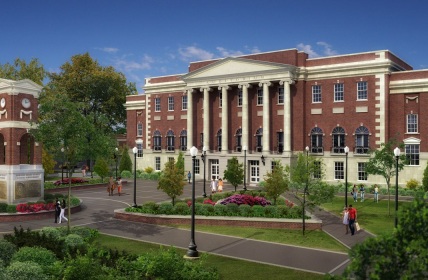 UA President Robert Witt has said he wanted a memorial plaza to recognize all of Foster Auditorium’s history, rather than focusing only on the 1963 “Stand in the Schoolhouse Door” speech and the University’s integration.
UA President Robert Witt has said he wanted a memorial plaza to recognize all of Foster Auditorium’s history, rather than focusing only on the 1963 “Stand in the Schoolhouse Door” speech and the University’s integration.
But a UA planner said Wednesday that as they received feedback from the community, many respondents said they thought including plaques about concerts and basketball games took away from the history of a key moment in the civil rights movement that happened there.
“People felt like if the plaza was going to commemorate the Stand, then remembering concerts along with it would take away from the impact,” said Dan Wolfe, University planner.
Today, the physical properties committee of the UA System Board of Trustees will approve the final design of the Malone Hood Plaza at Foster Auditorium, which will serve as an entrance to Foster as well as a commemoration of the building’s history.
Wolfe said the design will include the 40-foot Autherine Lucy clock tower at the center of the plaza with plaques around the base to tell the history of the Stand, the integration, Autherine Lucy Foster, Vivian Malone Jones and James Hood.
Foster was the first black student to be admitted to the University in 1956, but was later expelled over safety concerns by UA officials. The plaza is named for Jones, the first black student to graduate from the University, and Hood, who was admitted in 1963 along with Jones.
At the November board of trustees meeting, Finis St. John, president pro tempore of the board, said he thought the plaza would be a unifying issue for the community to focus on Foster’s history.
“We’re not going to agree to it if it doesn’t adequately portray the history,” St. John said at the time.
Wolfe said he thinks people will be happy with the final design of the plaza because they have been involved throughout the process. He said they received over 100 comments on a Web site where people could offer their suggestions for the plaza design along with open forums held in the fall.
“Because people feel like they were part of the process, I think they’ll be happy,” Wolfe said.
He said he thinks the dramatic plaza will become a new landmark for the campus.
“It’ll leave a lasting memory for people who go there to be able to understand what happened that day,” Wolfe said.
Inside the lobby, Wolfe said visitors will find kiosks where they can look up more detailed information about the Stand speech and other aspects of Foster Auditorium’s history.
While crafting the design, he said, the planners worked around the constraints of the athletics department to make the building functional for athletic events. There had to be a place for the visiting team to drop off athletes, an area to park trucks broadcasting the games and adequate parking.
“We knew we had to have a functional plan that would work well and do what it needed to,” he said.
In 2003, there were talks of razing Foster and turning it into a commemorative park. Now, the building’s renovations will turn it into a functional space to house the women’s basketball and volleyball programs.
The $16.5-million renovation of Foster includes $1.5 million for the plaza construction. The expected completion date for the plaza construction and building renovations is October.







